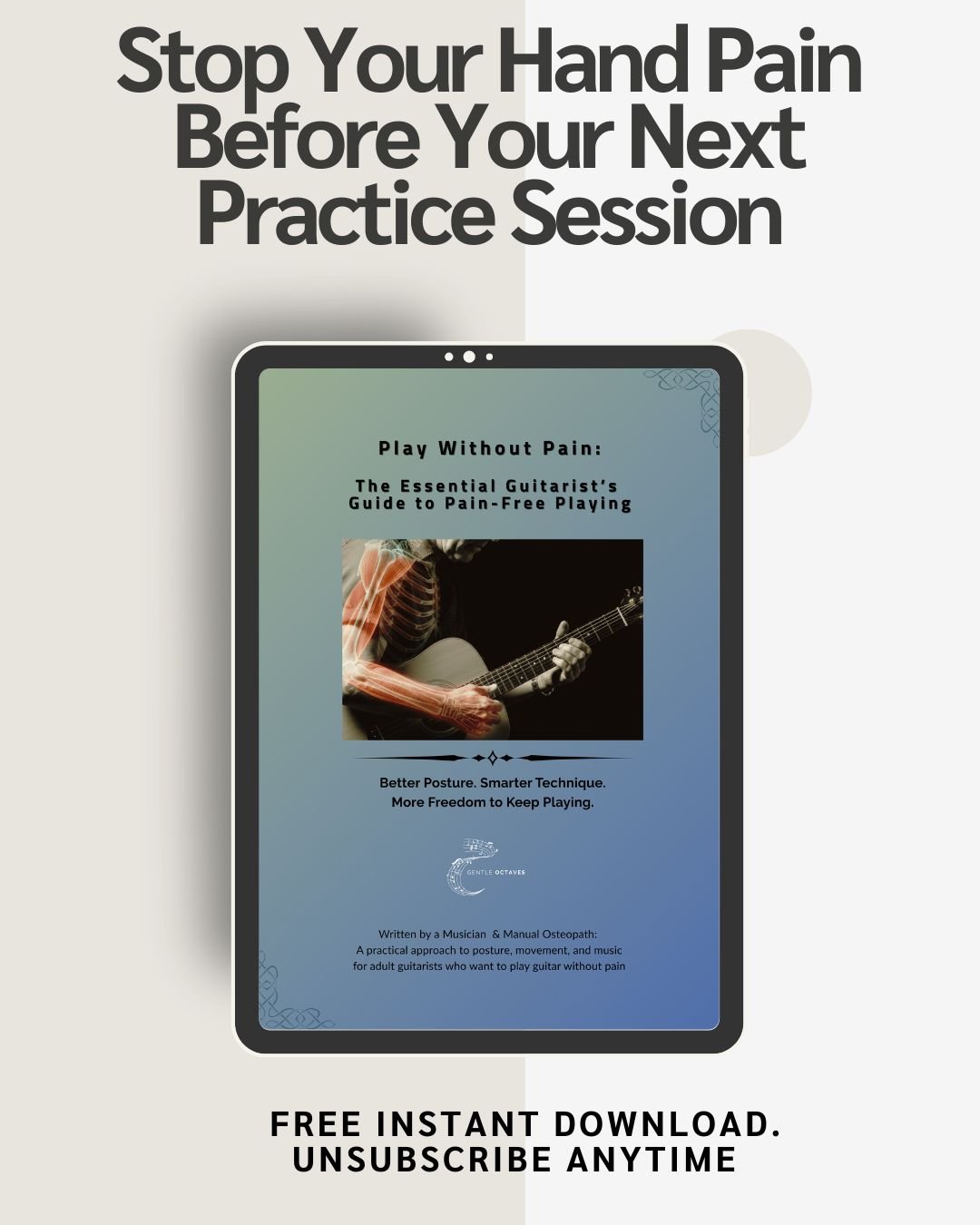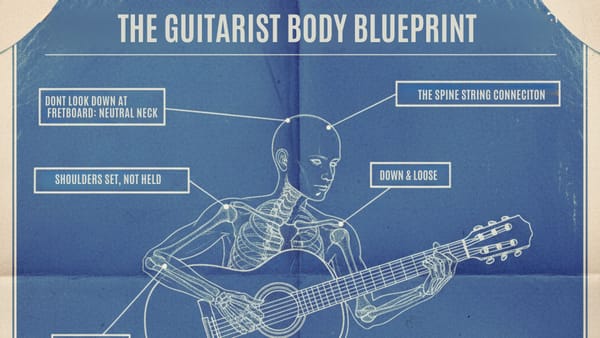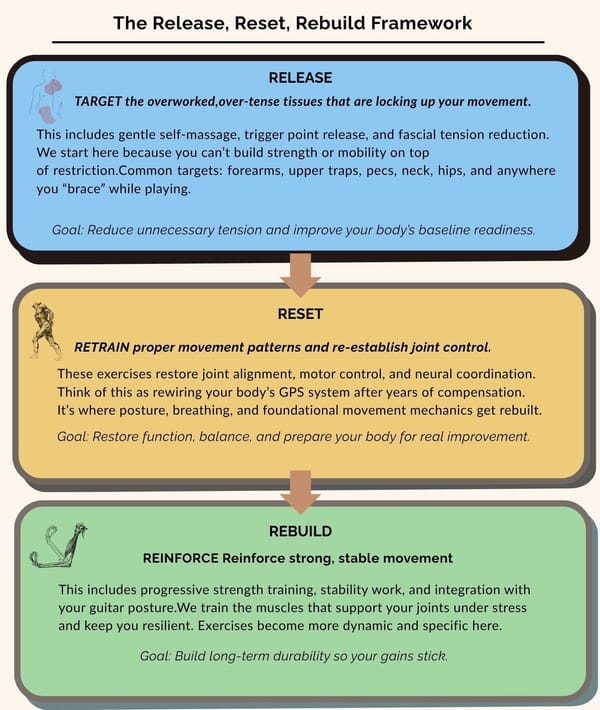Arthritis-Friendly Guitar Chords That Sound Great Without Hurting Your Hands
If standard guitar chords make your fingers feel like they’ve been put through a vice, you’re not doing it wrong: the shapes may be wrong for you.
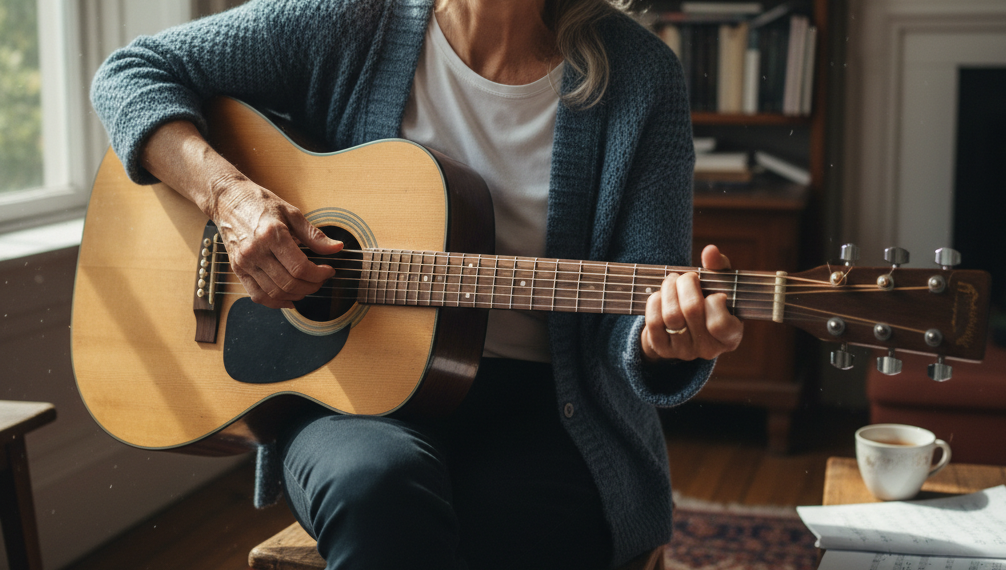
You know that F chord? The full barre, thumb crushing into the back of the neck, index finger flattened across all six strings like you're trying to squeeze juice from a stone?
Yeah, that one.
If you've got arthritis, or aging joints, or hands that just don't cooperate like they used to, that chord is basically a hostage situation.
And you've been told, implicitly or explicitly, that if you can't play it, you're not really a guitarist.
But here's what I've learned working with dozens of players over 40, many with arthritis, many coming back after years away, many who thought their playing days were done: you don't have to torture your hands to make beautiful music.
In this post, I'm going to show you why standard chord shapes hurt, give you five arthritis-friendly alternatives that sound just as good (sometimes better), and help you let go of the idea that struggling through pain makes you a better musician.
It doesn't. It just makes you sore.
Arthritis and aging joints aren’t a reason to quit. They’re a reason to adapt.
Why Your Hands Are Screaming (And Why That Matters)
So look, let's talk about what's actually happening when you try to play that big stretch F major or some massive barre chord that requires the grip strength of a rock climber.
Your joints aren't designed for that kind of sustained compression, especially if you've got arthritis or any degenerative changes happening in your fingers, wrists, or thumbs.
And I mean, most of us over 40 have something going on, even if we haven't been formally diagnosed. Collagen breaks down. Cartilage thins. Synovial fluid doesn't lubricate quite as well.
This isn't doom and gloom, it's just biology.
But here's where it gets interesting: the standard chord shapes we all learned were never optimized for joint health in the first place.
They were designed for sound, for tradition, for what worked on instruments centuries ago. Nobody was thinking about repetitive strain or joint angles or what happens when you play the same shapes for thirty years.
So when your thumb is jamming into the back of the neck with enough force to leave a dent, when your index finger is hyperextended across a barre, when your wrist is bent at an angle that would make an ergonomics expert wince: that's not you being weak.
That's the shape asking more from your body than it can reasonably give without consequence.
And the thing is, you don't have to do it that way.
There are alternatives. Shapes that give you the same harmonic richness, the same musical function, but without the joint-killing mechanics.
I've seen players go from wincing through every chord change to playing full sets, just by swapping out three or four shapes.
Not dumbing down the music. Not compromising the sound. Just working with their bodies instead of against them.
When we switch to guitar chords tailored for arthritis, we aim for:
- Less stretch between fingers (American College of Rheumatology, 2022)
- Minimal pressure from the thumb (University of Rochester Medical Center, 2021)
- Neutral wrist angles (Osteopathic International Alliance, 2021)
The Arthritis-Friendly Swaps (That Actually Sound Good)
Alright, so here's the practical bit. I'm going to give you five chord alternatives that I use with almost every client who comes in with hand pain. These aren't beginner chords. They're not lesser versions. They're just smarter choices. By the way you can also review my other post for 3 Exercises you can do if your a guitarist with Arthritis, if your looking for a good warmup prior to getting into these.
1. Fmaj7 instead of F major
The full F barre is a nightmare. Let's just say it. Thumb death, index finger flattened, wrist torqued. It's a lot.
Try this instead: xx3210

You're only fretting three strings. The xx's means you don't play those strings (just mute it or avoid it.) The open strings do most of the work. You get a beautiful, airy F major 7th sound that's honestly more interesting than the standard F anyway.
I had a client in her early sixties, came in with arthritis in both hands and said she'd given up playing because she couldn't hold an F chord anymore.
I showed her this shape. She looked at me like I'd just told her the sky was actually green. "That's it?" she said. Yeah. That's it. "Isn't that cheating?" she asked. "Does it sound like cheating?" I question back. " No" she said it "sounds nicer and I can actually play it"She's been playing again for two years now the F barre long forgotten about.
2. Cadd9 instead of C major
Standard C major isn't terrible, but it does require a bit of a stretch and some finger independence that can get harder as joints stiffen up.
Try this: x32030

Cadd9 is one of my favorite shapes. It's compact, minimal movement, sounds gorgeous. You can even hammer on and off that third finger on the B string for a little rhythmic variation, and suddenly you've got texture without any extra strain.
This one's great because it collapses the stretch. Your fingers stay close together, your hand stays in a more neutral position, and you get that open, ringing quality that makes acoustic guitars sound so good.
3. G6 instead of full G barre (or Even Standard G)
If you've been playing the three-finger G in first position (320033 or 320003), it's not the worst, but it can still create some awkwardness depending on your hand size and joint flexibility.
Try this: 320000
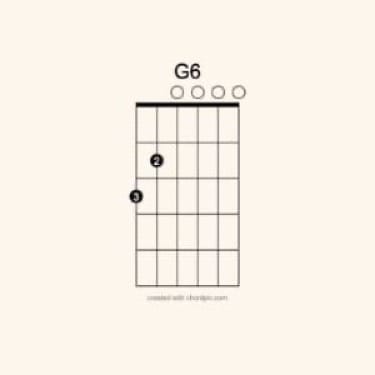
Just two fingers. Index on the A string, middle on the low E. Everything else rings open. You get this big, spacious G6 sound that's perfect for folk, country, singer-songwriter stuff, really anything where you want the guitar to breathe.
The open strings do the heavy lifting. Your hand barely has to work. And honestly? It sounds better than a cramped, muted G where you're struggling to keep your ring and pinky from touching other strings.
4. Am7 instead of Am barre
Am in first position (x02210) is usually fine, but if you're moving between chords a lot or playing for extended periods, even that can add up.
Try this: x02010

Am7. One less finger. Softer, more mellow, kind of bluesy. You lose the C note on the B string, but you gain ease and a slightly jazzier flavor. I use this one all the time when I'm playing for longer sessions or when my hands are already tired from a day of treatment work.
It's one of those shapes that makes you realize you were working way harder than you needed to. You don't have to grip. You don't have to press. You just place your fingers and let the guitar do its thing.
5. Dsus2 instead of D major
D major (xx0232) isn't brutal, but it does ask your ring and middle fingers to stack in a way that can be uncomfortable if you've got any joint inflammation or stiffness in your knuckles.
Try this: xx0230

Dsus2. You're just using your index and middle fingers. No pinky, no cramped angle, no weird hand position. It's open, modern-sounding, kind of ethereal. Works beautifully in fingerpicking or strumming patterns.
And here's the thing: suspended chords like this have this unresolved quality that actually adds emotional weight to songs. So you're not losing anything musically. You're gaining both comfort and colour.
How to Make the Switch Without Feeling Like You're Cheating
I know what you might be thinking. "But isn't this just... easier? Am I taking shortcuts?"
No. You're adapting.
There's this idea, especially in guitar culture, that suffering equals authenticity. That if it doesn't hurt, you're not really earning it. But that's nonsense. That's just machismo dressed up as musicianship.
The goal isn't to prove how much pain you can endure. The goal is to make music. To express something. To enjoy the act of playing. And if you can do that without shredding your joints in the process, that's not cheating. That's wisdom.
Here are a few practical tips for making these swaps stick:
Use pivot fingers
When you're moving between chords, keep one finger anchored if you can. It reduces the total amount of movement your hand has to make, which reduces strain. For example, if you're going from Cadd9 to Am7, your middle finger can stay on the D string. One less thing to reposition.
Lift fingers just enough
You don't need to helicopter your fingers up off the fretboard every time you change chords. Just lift them enough to clear the strings. Micro-movements. Save energy. Your hand will thank you.
Go slow at first
Speed will come back once the shapes feel natural. Don't rush it. The fastest players in the world got there by being patient with themselves in the practice room. Let muscle memory do its thing. Trust the process.
When to Use These Shapes (Spoiler: Anytime You Want)
So here's the truth: you can use these shapes all the time if you want.
You don't need permission. You don't need to wait until your hands are screaming. You don't need a diagnosis or a doctor's note or proof that you've earned the right to play comfortably.
If these shapes feel better, use them. Period.
That said, they're especially useful:
- In long practice sessions or gigs where you need to conserve energy
- When you're coming back to guitar after a break and your hands need time to rebuild strength and flexibility
- Anytime your joints are inflamed or sore from arthritis, overuse, or just life
- When you're learning new songs and want to focus on rhythm and feel without battling difficult shapes
I've worked with players who use these exclusively now. Their audiences can't tell the difference.
The only difference is they can play longer, enjoy it more, and wake up the next day without their hands feeling like they've been through a meat grinder. Review my other post fro more ways to ensure your setting yourself up t keep playing longer: 5 Ways to Reduce Guitar Hand Pain and Keep Playing for Years
Try This: The 5-Minute Chord Swap Challenge
Here's something you can do right now, today, to start integrating these shapes into your playing:
- Pick one song you already know.
- Identify the chord that gives you the most trouble. Usually it's F, but it might be something else.
- Swap in one of the alternatives I've given you.
- Play through the song slowly, focusing on how your hand feels.
- Notice:
- Is there less tension in your thumb?
- Does your wrist feel more neutral?
- Can you hold the shape longer without discomfort?
- After playing, write down one thing you noticed. Just a sentence. "Thumb didn't ache." "Transition to G was smoother." Whatever.
Do this for a week. One song, one swap, one observation. You'll start to feel the difference before you even hear it. And once you feel it, you won't want to go back.
Your Invitation
If you're dealing with arthritis, joint pain, or hands that just don't move like they used to, I'd love to hear which of these swaps felt most helpful.
Try one today and reply to this post to let me know how it went. Did it feel easier? Did the sound surprise you?
And if you want more body-friendly strategies for playing guitar without pain, I've put together a free guide with posture resets, hand stretches, and practical tips for aging musicians:
Download: The Gentle Octaves Guide to Pain-Free Playing
Inside, you'll find:
- Posture adjustments that reduce strain on your back, shoulders, and wrists
- Pre-practice warm-ups designed for stiff hands
- Troubleshooting tips for common pain points (thumb, wrist, elbow)
No hype. No gimmicks. Just practical help from someone who's spent decades working with bodies and guitars.
You don’t adapt to keep playing longer , you play longer because you adapt.
F.P
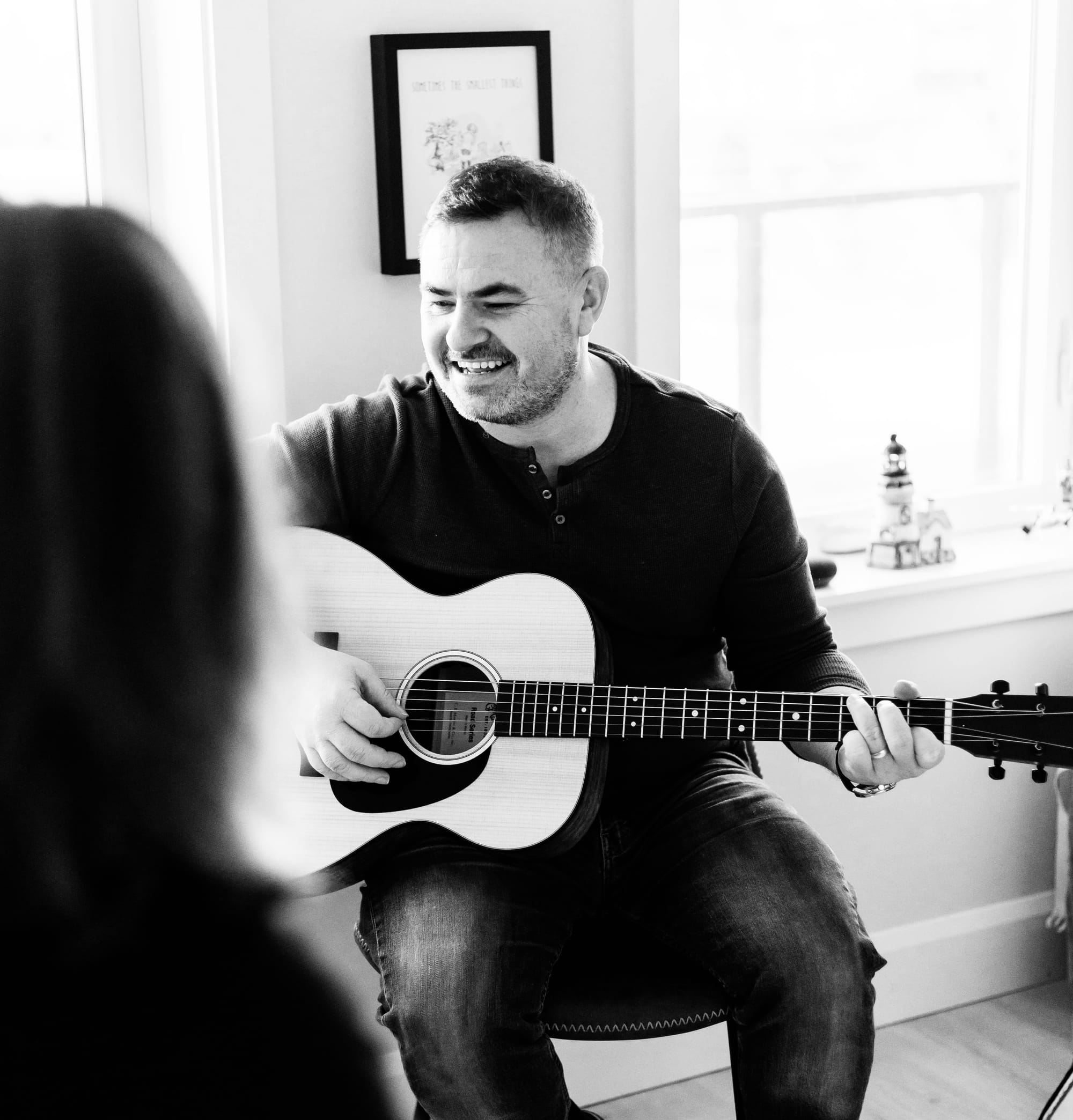
F.P. O’Connor
F.P. O’Connor is a manual osteopath, psychology grad, and lifelong musician who helps adults play with less pain and more confidence.
Through Gentle Octaves Studio, he blends science, movement, and musicianship to help mature players keep creating for life.
Release → Reset → Rebuild™ your sound
FAQ
Q: Can I still play guitar chords if I have arthritis or joint pain in my hands?
A: Yes absolutely. Arthritis doesn't mean you stop. It means you adapt. The shapes I've shared here reduce joint strain, minimize awkward stretches, and let you keep playing comfortably for years.
Q: Will swapping chords change the sound of the song?
A: Not in any way that matters. These alternatives are musically rich often more interesting than the standard shapes. The audience won't notice. Your hands will.
Q: What if I've been playing standard shapes for decades — is it worth switching now?
A: Yes. Especially if you're experiencing pain. Relearning a few chord shapes is far easier than dealing with chronic joint damage or giving up playing altogether. Small changes now protect your hands for the long haul.
Q: Are these "beginner" chords, or can experienced players use them too?
A: These aren't beginner chords they're smart chords. Plenty of professional players use these exact shapes in recording and performance. Experience doesn't mean suffering through pain. It means knowing when to adapt.
Q: What other adjustments help playing with arthritis beyond chord shapes?
A: Several strategies help: using lighter gauge strings, lowering your guitar's action, changing to open tunings or using a capo, warming up your hands before playing, and checking your posture. It's all connected: body, instrument, technique.
Sources & Science
- American College of Rheumatology. (2022). Hand and wrist exercises for arthritis. https://rheumatology.org
- University of Rochester Medical Center. (2021). Playing instruments with arthritis. https://urmc.rochester.edu
- Osteopathic International Alliance. (2021). Osteopathic principles and practice overview. https://oialliance.org


